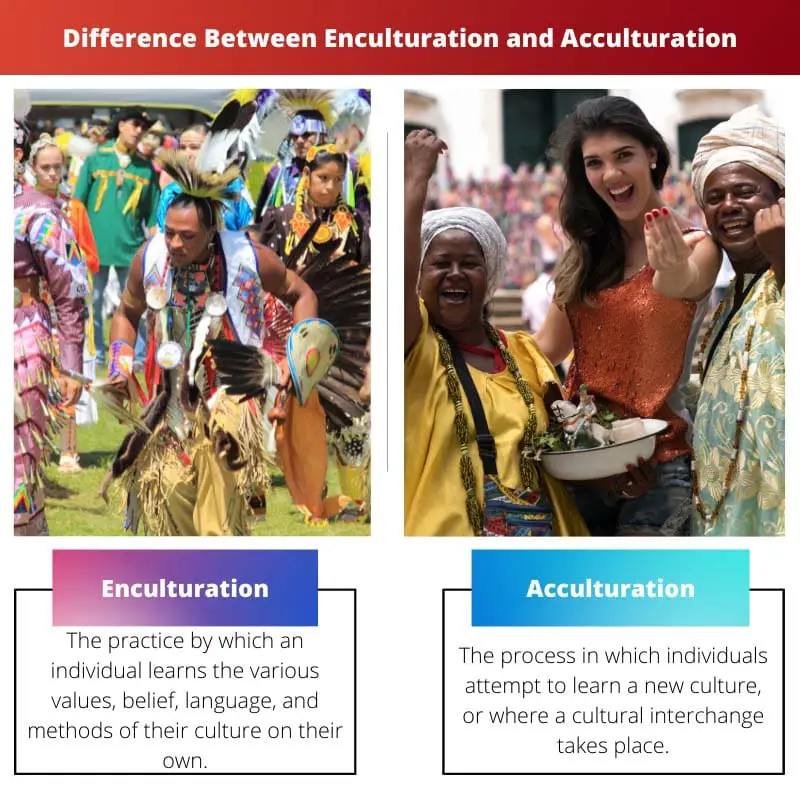Enculturation refers to the process by which individuals learn and internalize the cultural norms, values, and practices of their own society or community from a young age through socialization. On the other hand, acculturation involves the adaptation and integration of individuals or groups into a new culture, often occurring when individuals move to a different society or encounter a different cultural group
Key Takeaways
- Enculturation is the process of learning and adopting the values, beliefs, and customs of one’s own culture; acculturation is the process of adapting to and adopting elements of a new or different culture.
- Enculturation occurs throughout a person’s life as they absorb the norms and practices of their native culture; acculturation happens when individuals or groups come into contact with another culture, due to immigration or cultural exchange.
- Both enculturation and acculturation shape a person’s cultural identity and understanding, but enculturation focuses on acquiring one’s own culture, while acculturation involves adapting to a different cultural environment.
Enculturation vs Acculturation
The difference between enculturation and acculturation is that the former is how individuals attempt to learn about their culture through self-exploration and acquisition. The latter deals with intermixing the traditions of two different cultures.

Enculturation is the process by which one learns about their culture independently and with the help of their acquisition. The individual here learns about their culture’s practices and the various other characteristics of it.
Acculturation is the process by which one mixes components of two different cultures. In sociological terms, this is called cultural interchange, and here the individual learns and adapts to the practices of the culture which they are not familiar with.
Comparison Table
| Feature | Enculturation | Acculturation |
|---|---|---|
| Definition | The process of learning and acquiring the knowledge, values, customs, and behaviors of one’s own culture. | The process of learning and adopting the cultural traits of another group, often due to contact or interaction. |
| Context | Occurs within a single cultural environment. | Often occurs in situations where two or more cultures come into contact, such as through migration, globalization, or colonization. |
| Focus | Internalizing and transmitting cultural norms and practices to the next generation. | Adapting to and potentially modifying existing practices to fit a new cultural context. |
| Direction | Unidirectional, from the existing culture to the individual. | Bidirectional, involving both adaptation and potential influence on the dominant culture. |
| Goal | Enables individuals to function effectively within their society and understand their roles and responsibilities. | Facilitates integration and adaptation into a new cultural environment. |
| Examples | A child learning their native language, customs, and traditions from family and community. | Immigrants adopting the language, customs, and dress of their new host country. |
What is Enculturation?
Introduction to Enculturation
Enculturation is a fundamental process through which individuals learn and acquire the beliefs, values, norms, customs, behaviors, and language of their culture or society. It is a lifelong process that begins from infancy and continues throughout one’s life, shaping an individual’s identity and social interactions within their cultural context.
The Process of Enculturation
Enculturation involves various mechanisms and experiences that contribute to the internalization and adoption of cultural knowledge and practices. These mechanisms include:
1. Socialization
- Socialization refers to the process by which individuals learn the norms, roles, and values of their society through interactions with family members, peers, educators, and other social agents.
- Within the family unit, children observe and imitate the behaviors of their parents and older siblings, learning cultural practices through direct instruction, modeling, and reinforcement.
2. Language Acquisition
- Language plays a crucial role in enculturation as it serves as a medium through which cultural knowledge is transmitted.
- Through language acquisition, individuals learn not only the vocabulary and grammar of their native tongue but also the cultural nuances embedded within language, including idioms, expressions, and cultural-specific terms.
3. Cultural Transmission
- Cultural transmission involves the transfer of cultural knowledge from one generation to the next. This transmission occurs through various channels such as oral traditions, rituals, ceremonies, storytelling, and formal education.
- Elders, community leaders, and cultural institutions play significant roles in imparting cultural wisdom and practices to younger generations.
4. Cultural Practices and Rituals
- Participation in cultural practices and rituals reinforces cultural identity and values. These practices can include religious ceremonies, rites of passage, festivals, and traditional customs.
- Engaging in these activities fosters a sense of belonging and connection to one’s cultural heritage, providing individuals with a framework for understanding their place within society.
5. Cultural Exposure
- Exposure to diverse cultural experiences, both within one’s own community and through interactions with other cultures, enriches the process of enculturation.
- Travel, media, literature, and multicultural environments offer opportunities for individuals to broaden their understanding of different cultural perspectives and norms, contributing to a more nuanced and adaptable cultural identity.

What is Acculturation?
Introduction to Acculturation
Acculturation is a socio-cultural process that occurs when individuals or groups from different cultural backgrounds come into continuous contact and interact with one another. It involves the exchange and adoption of cultural elements, including beliefs, values, practices, behaviors, and symbols, between distinct cultural groups. Acculturation can occur in various contexts, such as immigration, colonization, globalization, or through intercultural communication and exchange.
Mechanisms of Acculturation
1. Cultural Contact and Interaction
- Acculturation begins with cultural contact, where individuals from different cultural backgrounds encounter one another in social, economic, or political contexts.
- Interactions between cultural groups facilitate the exchange of cultural knowledge, practices, and norms, leading to mutual cultural influence and adaptation.
2. Cultural Learning and Adaptation
- Acculturation involves the process of cultural learning, where individuals acquire knowledge and skills from the dominant culture while retaining elements of their original culture.
- Individuals may adapt to new cultural norms and behaviors through observation, imitation, and socialization within the host society.
3. Identity Formation and Negotiation
- Acculturation influences individuals’ identity formation as they navigate between their original cultural identity and the identity of the dominant culture.
- Identity negotiation involves reconciling conflicting cultural values, beliefs, and practices, leading to the development of hybrid or bicultural identities.
4. Cultural Integration and Syncretism
- Acculturation can result in cultural integration, where individuals incorporate aspects of both their original culture and the dominant culture into their daily lives.
- Syncretism occurs when cultural elements from different traditions merge or blend to create new cultural expressions, beliefs, or practices.
Outcomes of Acculturation
1. Assimilation
- Assimilation involves adopting the cultural norms and values of the dominant culture while relinquishing aspects of one’s original culture.
- Individuals who assimilate may fully integrate into the dominant culture, often at the expense of their cultural heritage.
2. Integration
- Integration entails maintaining elements of both the original culture and the dominant culture, resulting in a balanced and bicultural identity.
- Integrated individuals navigate between cultural contexts while preserving their cultural heritage and participating in the broader society.
3. Separation
- Separation occurs when individuals maintain their original cultural identity while avoiding interactions with the dominant culture.
- This may lead to cultural isolation or the formation of ethnic enclaves within the host society.
4. Marginalization
- Marginalization involves the rejection of both the original culture and the dominant culture, leading to feelings of alienation and social exclusion.
- Marginalized individuals may struggle to find a sense of belonging within either cultural context.

Main Differences Between Enculturation and Acculturation
- Enculturation:
- Involves the process of learning and internalizing the cultural norms, values, and practices of one’s own culture since birth.
- Primarily occurs within the context of one’s family, community, and societal environment.
- Shapes an individual’s identity and social interactions within their native cultural context.
- Often characterized by the transmission of cultural knowledge from one generation to the next.
- Focuses on the acquisition of language, social norms, and cultural customs specific to one’s own cultural group.
- Acculturation:
- Occurs when individuals or groups come into contact with a different cultural group and adopt some of their cultural practices and norms.
- Involves interactions between distinct cultural groups, such as immigrants adapting to a new cultural environment.
- Leads to changes in individuals’ cultural identity and behaviors as they adapt to the norms of the dominant culture.
- Can result in various outcomes, including assimilation, integration, separation, or marginalization.
- Often involves a negotiation between one’s original cultural identity and the identity of the dominant culture.

- https://www.sciencedirect.com/science/article/pii/S0147176708001004
- https://tspace.library.utoronto.ca/bitstream/1807/11842/1/nq35180.pdf

An intellectually stimulating discourse on enculturation and acculturation, providing a profound comprehension of the sociocultural dynamics at play.
The thought-provoking analysis of enculturation and acculturation in this post is intellectually engaging and enlightening.
The post offers a scholarly and insightful analysis of enculturation and acculturation, deepening our understanding of cultural sociology.
The post offers a sophisticated and scholarly analysis of enculturation and acculturation, presenting a rich exploration of these sociological terms.
The post effectively delves into the intricate details of enculturation and acculturation, providing a nuanced perspective on these sociological phenomena.
An erudite and comprehensive discussion of cultural concepts that is highly informative and engaging.
The distinction between enculturation and acculturation is clearly outlined, making the reader’s understanding of these concepts very comprehensive.
I appreciate the well-structured nature of the post, it’s easy to follow and engaging.
The post effectively captures the nuances of both terms in sociology, providing a well-rounded analysis.
This post provides a lucid and illuminating exploration of enculturation and acculturation, making it a valuable resource for those interested in sociology.
The in-depth examination of enculturation and acculturation is commendable, as it offers a comprehensive understanding of these sociological concepts.
I found the post to be enlightening and intellectually stimulating, a great read overall.
A well-researched and articulate presentation of enculturation and acculturation, providing valuable insights into the cultural aspects of sociology.
The nuanced and perceptive examination of enculturation and acculturation is intellectually enriching, offering an insightful lens into cultural sociology.
The post presents a sophisticated and rigorous analysis of enculturation and acculturation, enhancing our understanding of cultural sociology.
An insightful and informative post that clearly explains the concepts of enculturation and acculturation. The comparison table is particularly helpful in understanding the differences between the two processes.
I appreciate the detailed explanations provided, they really shed light on these sociological terms.
I agree, the post is very thorough and well-researched.
This post does an excellent job of breaking down the complex concepts of enculturation and acculturation into easily understandable terms. Well done!
Agreed, the clarity of the explanations makes this post very accessible to readers.
The meticulous comparison between enculturation and acculturation is insightful and thought-provoking, offering a profound understanding of these cultural processes.
I concur, the post provides a compelling analysis of enculturation and acculturation, offering valuable insights into the cultural dynamics within sociology.
This post delivers a compelling and persuasive discussion of enculturation and acculturation, contributing to a deeper comprehension of cultural sociology.
A comprehensive and profound examination of enculturation and acculturation, effectively elucidating the complexities of these sociocultural phenomena.
The post offers a discerning and insightful analysis of cultural concepts, fostering a deeper understanding of enculturation and acculturation.
An intellectually stimulating exploration of enculturation and acculturation, providing valuable knowledge on the cultural dynamics within sociology.